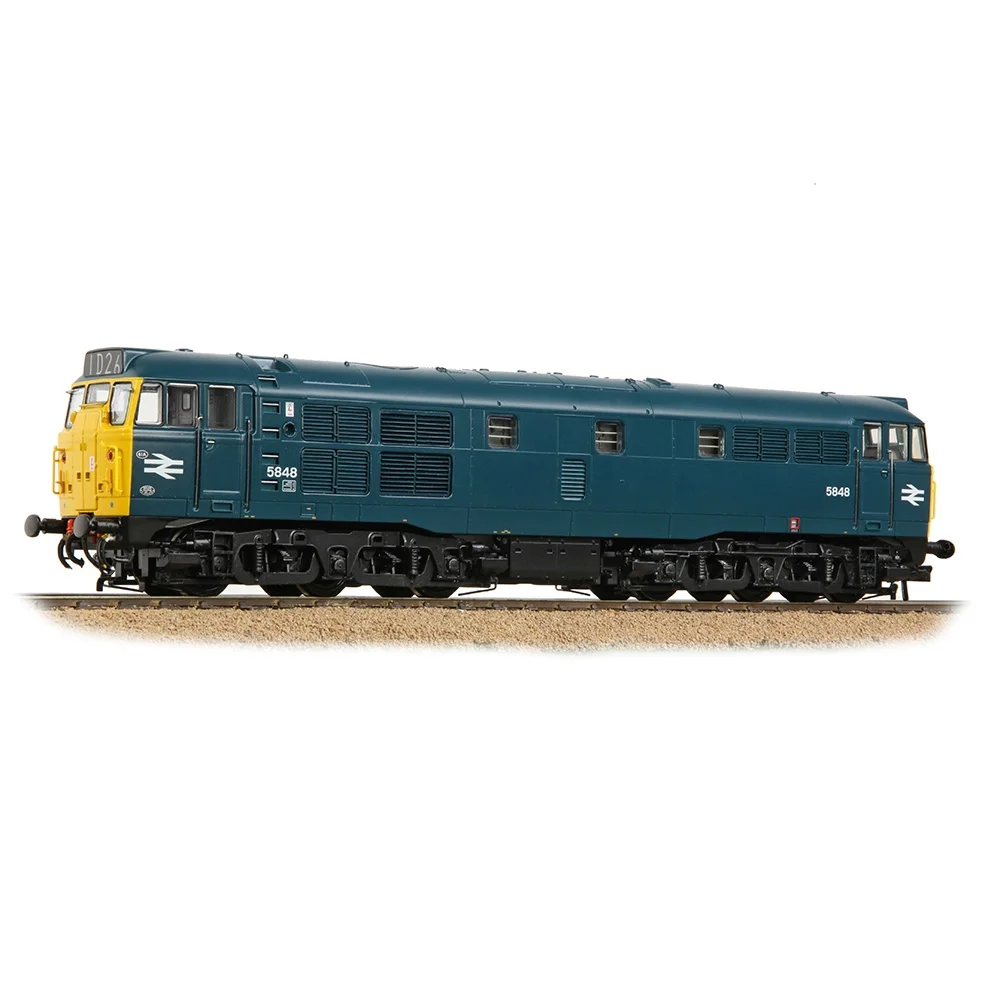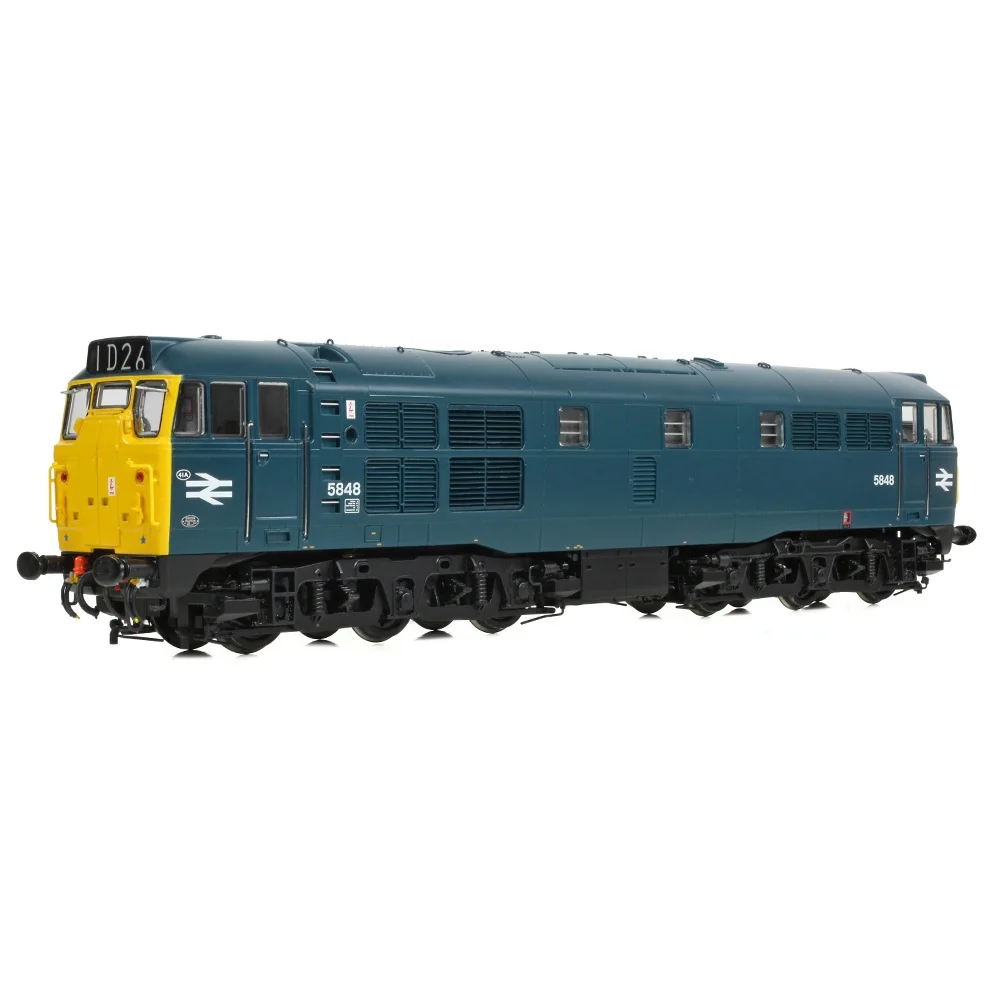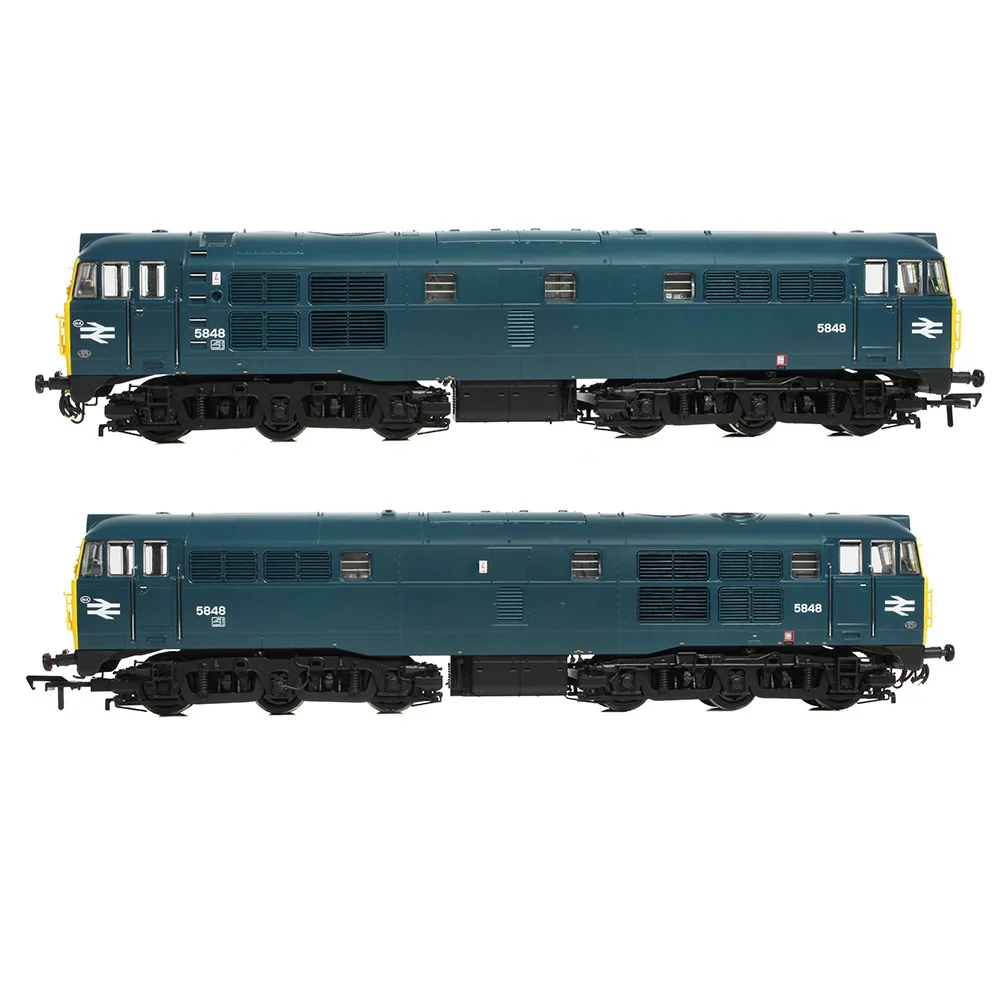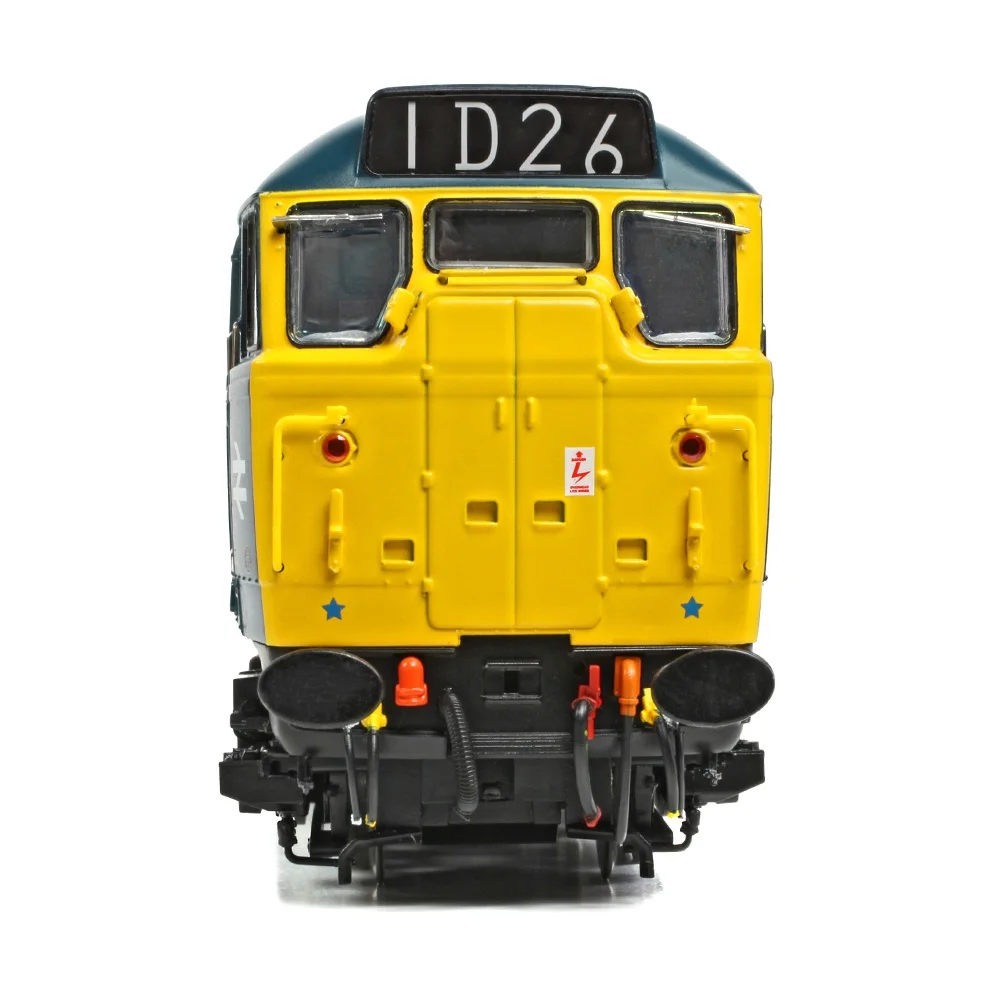Bachmann 35-803A
British Rail Class 31/1 5848 British Rail Blue
Bachmann's Description & Specifications
The Brush Type Twos – Class 30s and Class 31s – by Bachmann Branchline are back and better than ever, now featuring a Bach-Up Stay Alive System fitted as standard and all-wheel electrical pickup assuring the smooth and powerful performance you’ve come to expect from Bachmann Branchline models.
With high fidelity mouldings, numerous separately fitted parts and countless tooling variations to capture the minutiae of the real locomotives throughout their lives, our new Class 30 is brought to life with an exquisite livery application using true-to-prototype colours, fonts and logos. Along with an unprecedented array of lighting features, our Dual Fitted speaker system is fitted to all models – bringing to life our SOUND FITTED models. For the ultimate experience, choose one of our SOUND FITTED DELUXE models with their motorised radiator fan, authentic tinted windscreen glazing and hands-free DCC-uncoupling thanks to Bachmann’s revolutionary Auto-Release Coupling System!
Depicting a Class 31/1, this locomotive has had its Mirrlees engine replaced with an English Electric 12SVT and the Branchline model faithfully recreates this, with the correct roof exhaust ports and 12SVT engine block detail visible through the bodyside windows.
- Bachmann Branchline OO Scale
- Era 6
- Pristine BR Blue livery
- Running No. 5848
- Equipped with a Plux22 DCC Decoder Socket - recommended Decoder item No. 36-570B
- Length 228mm
DETAIL VARIATIONS SPECIFIC TO THIS MODEL
- Original Body
- Original Gangway Doors
- Glazed Headcode Panels - displaying Blinds 1D26 and 2B63
- Windscreen Washer Jets with Covers
- Modified Bufferbeam Cowling
- Original Windscreen
- Original Main Fan Grilles with Horizontal Fins
- English Electric Exhaust Ports
- English Electric Engine Block Detail
- Original Open Boiler Port
- Original Water Filler Hatch
- Open Bodyside Steps
- Original Battery Boxes
BACHMANN BRANCHLINE CLASS 30/31 SPECIFICATION
MECHANISM:
- Five pole, twin shaft motor with two flywheels providing drive to both bogies
- All axle drive
- Electrical pickup from all wheels on each bogie
- Separate metal bearings fitted to each axle
- Diecast metal chassis block and bogie towers
- Diecast metal gearboxes, with gearing arranged for prototypical running speeds and haulage capabilities
- 16.5mm (OO gauge) wheels to NEM310 & NEM311 standards with authentic profile and detailing
- Detachable coupling pockets to NEM362 standards fitted to each bogie
- Auto-Release Couplings fitted at both ends – DCC operated, hands-free uncoupling with the press of a function button (SOUND FITTED DELUXE models only)
- Designed to operate on curves of second radius (438mm) or greater
DETAILING:
- Bogies constructed from multiple components featuring full relief detail
- Rotating radiator fan, driven by an independent motor and gearbox, operated as part of the sound project on DCC and Analogue control (SOUND FITTED DELUXE models only)
- Tinted windscreen glazing (Driver and Second Man windscreens only as per the prototype, SOUND FITTED DELUXE models only)
- Separately applied metal detail parts, including grab handles, windscreen wipers and etched fan grilles
- Sprung metal buffers
- Each model supplied with a full set of decorated, model-specific bufferbeam pipework and accessory parts including three-piece, body-mounted snow ploughs
LIGHTING:
- Directional lighting, including illuminated headcode panels and high intensity headlights where applicable, switchable on/off at either end on DCC or Analogue control
- Cab lighting*, assigned to two DCC functions for separate switching of each
- Separately switched Engine Room lighting*
- Single or twin red tail lights* (*when used on DCC)
- Authentic light colours and temperatures selected for each model based on era and application
DCC:
- Plux22 DCC decoder interface
- Bach-Up Stay Alive Systemproviding uninterrupted power to prevent stalling, light flicker and sound cut-outs (operates on DCC only)
SOUND:
- Two quality speakers employed for optimum sound reproduction, fitted to every model as standard
- Zimo MS450P22 DCC Sound Decoder fitted to SOUND FITTED and SOUND FITTED DELUXE versions
- Two sound projects to accurately capture the sounds of Class 30 (Mirrlees Engine) and Class 31 (English Electric Engine)
- Sound files for each project produced specifically for the Bachmann Branchline Class 30/31 using recordings from real locomotives and archive audio
- SOUND FITTED and SOUND FITTED DELUXE models operate on DCC and Analogue control as supplied. On Analogue, an authentic engine start up sequence and running sounds are produced when power is applied
LIVERY APPLICATION:
- Authentic liveries applied to all models
- Multiple paint applications employed on each model using BR and corporate specification colours
- Logos, numerals and text added as appropriate using multi-stage tampo printing using authentic typefaces, logos and colours
- In addition, where applicable Etched Nameplates and Plaques are also provided
Class & Prototype
- Class: British Rail Class 31/1
- Traction: Diesel
- Transmission: Electric
- Built: 1957-1962
- Total Built: 263
The Brush Type 2 represents one of British Railways' most remarkable transformation stories. Built by Brush Traction between 1957-1962, these 263 A1A-A1A diesel-electric locomotives initially struggled with unreliable Mirrlees engines, earning TOPS classification as Class 30. The comprehensive re-engining programme of 1964-1969 replaced the problematic powerplants with proven English Electric 12SVT engines, transforming them into dependable Class 31 locomotives that served for over 50 years. Originally nicknamed "Toffee Apples" (pilot batch) and "Skinheads" (early production), they evolved from operational liability to versatile workhorse, handling everything from branch line passenger services to main line freight duties. The class demonstrates how systematic engineering solutions can rescue unsuccessful designs, with the final locomotive withdrawn in 2017 after six decades of service. Today, 36 examples survive in preservation, whilst excellent ready-to-run models from Accurascale, Hornby, and Bachmann enable authentic recreation of both Class 30 and Class 31 configurations across multiple scales and eras.
- Running Number: 5848
- Name: -
- Ordered By: British Railways
- Built By: Brush Traction
- Built At: Brush Traction
- Built: 07/1962
- Withdrawn: 09/1982
- Length of Service: 20.2 years
- Running Numbers: BR D5848, BR 5848, BR 31314
- Names: -
Built by Brush Traction in July 1962, D5848 entered service in BR green with small yellow warning panels, allocated to the Eastern Region. Like all early Brush Type 2s, it was originally a Class 30 with a Mirrlees JVS12T engine, but was re-engined with the English Electric 12SVT in the late 1960s, becoming a Class 31/1.
By the end of the 1960s, steam traction was almost gone, and BR began omitting the "D" prefix from diesel numbers. After a repaint, D5848 simply carried 5848 in BR blue—placing it in that short, late-pre-TOPS window between 1968 and 1974. Under the TOPS renumbering scheme, it became 31314 in May 1974.
Its career was shorter than many classmates: 31314 was withdrawn in September 1982. In service, it worked a mix of secondary passenger and freight turns, and in its later years likely saw engineers’ and departmental duties. For modellers, it’s a perfect subject for layouts set in the BR blue era, especially if you want to capture that distinctive “no-D” numbering period.
Operator & Livery
- Operator: British Rail
- Livery: Blue
British Rail (1965-1997) transformed Britain's railways through revolutionary modernisation, introducing the iconic double arrow logo, Rail Blue livery, and business sectorisation. BR pioneered high-speed rail with the InterCity 125 and Advanced Passenger Train, electrified major routes, and created profitable divisions like InterCity and Network SouthEast. From steam succession through diesel and electric development to privatisation preparation, British Rail's diverse locomotive fleet, multiple livery schemes, and operational scenarios provide unparalleled variety for railway modellers across all scales and periods.
BR Blue, also known as Rail Blue or Monastral Blue, was introduced in 1965 as part of British Rail's comprehensive corporate identity overhaul that accompanied the rebranding from British Railways to British Rail. The colour was officially defined by British Standards BR28/6001 (airless spray finish) and BR28/5321 (brush finish), representing a dark, greyish blue tone specifically chosen to hide dirt and weathering effects well.
The livery was prototyped on the experimental XP64 train in 1964 before becoming the standard scheme from 1 January 1965. Rail Blue was applied to all diesel and electric locomotives with yellow warning panels (initially small, then extending to full yellow ends from 1966). The standardised application included the iconic double arrow logo and Rail Alphabet typeface, creating one of the most successful transport corporate identities of the 20th century.
The livery dominated British Rail operations for over two decades until sectorisation in the 1980s began fragmenting the unified appearance. Despite initial colour fading problems in early applications, these were resolved by the late 1970s when the Large Logo variant was introduced featuring extended yellow areas and full-height double arrow symbols. Rail Blue's enduring appeal among railway enthusiasts reflects its role as the definitive British Rail image during the organisation's most unified period.





